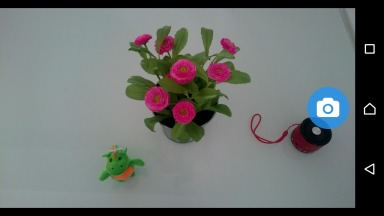XCamera: Android-optimized camera widget
XCamera is a widget which extends the standard Kivy Camera widget with more functionality. In particular:
-
it displays a "shoot button", which the user can press to take pictures
-
on Android, it uses the native APIs to take high-quality pictures, including features such as auto-focus, high resolution, etc.
-
it includes a method to force landscape mode. On Android, it is often desirable to switch to landscape mode when taking pictures: you can easily do it by calling
camera.force_landscape(), and latercamera.resource_orientation()to restore the orientation to whatever it was before.
Screenshot:
Notes:
-
On Android, the
resolutionproperty of theXCamera(and also of the plainCamera) widget controls the preview size: in other words, it only affects the quality of the preview, not the size of the pictures taken. -
As it is now, the camera will shoot using the default setting for the picture size, which seems to be what the camera think it is "the best". In theory, we could add a method to retrieve the list of all possible picture sizes, and add a property to control it. It would also be nice to add a new button to allow the user to manually select the preferred size. Pull requests are welcome :)
Install & Usage
xcamera is available on PyPI.
Therefore it can be installed via pip.
pip3 install xcameraOnce installed, the demo should be available in your PATH and can be ran from the command line.
xcameraAnd the widget can be imported via:
from kivy_garden.xcamera import XCameraDemo
A full working demo is available in src/kivy_garden/xcamera/main.py. You can run it via:
make runDevelop & Contribute
To play with the project, install system dependencies and Python requirements using the Makefile.
makeThen verify everything is OK by running tests.
make testIf you're familiar with Docker, the project can also run in a fully isolated container.
First build the image.
make docker/buildThen you can run tests within the container.
make docker/run/testOr the application itself.
make docker/run/app